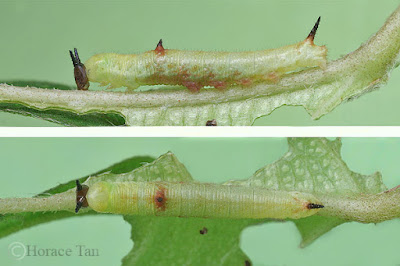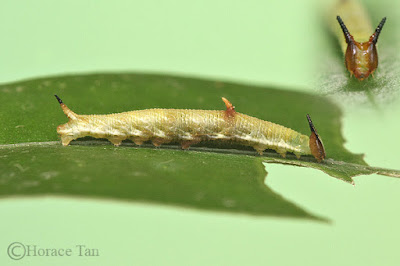Butterfly Biodata:
Genus: Chersonesia Distant, 1883
Species: Species: peraka Distant, 1884
Sub-species: peraka Distant, 1884
Wingspan of Adult Butterfly: 34mm
Caterpillar Local Host Plant: Ficus punctata (Climbing Fig, Family: Moraceae).
A Little Maplet resting on the underside of a leaf in the nature reserve.
Physical Description of Adult Butterfly:
A rather small and delicate butterfly. Above, the wings are orange brown with a number of dark transverse lines and stripes crossing from costa to dorsum. Compared to the other Chersonesia species, Little Maplet has a double postdiscal band, and the two bands internal to it are wide. The underside is marked similarly but with a yellowish brown color
Field Observations:
In Singapore the Little Maplet is fairly uncommon. The adults are sighted at only a few sites in northern Central Catchment Area, despite the fact the host plant is readily found in the entire catchment area and other parts of Singapore. Adults fly with a feeble but erratic flight, and they typically confined themselves to sheltered and shady habitats. When settling at a perch to feed or rest, their wings are opened outspread. They also have a habit of stopping on the leaf underside when perching.
Early Stages:
The host plant, F. punctata is a root-climber, commonly found creeping on forest floor or up tree trunks in the nature reserves and many roadside trees. At times they can be found creeping up walls (one example is the gravestone walls surrounding Fort Canning Green in Fort Canning Park) or even lamp posts. It has leathery and usually obovate leaves. The ripe figs are bright orange with white spots.
Host plant: F. punctata. Left: creeping up a tree trunk; Right: ripened orange figs.
A female Little Maplet laying egg on a leaf of the host plant growing among leaf debris.
The mother Little Maplet lays its eggs singly on the upperside of a relatively young leaf of the host plant. All four eggs sighted so far had all been laid at or very near the edge of the leaf. Characteristic of species in the Cyrestini tribe, each yellow egg has a flattened top where the micropylar sits. From the rim of this top, vertical ridges reach down the side wall to the base. Diameter of egg: 0.6-0.7mm.
An egg of the Little Maplet at leaf edge of the host plant.
Top: mature egg of the Little Maplet with the brown head capsule discernible. Bottom: empty egg shell showing the "trap door" with which the caterpillar made its exit earlier.
The egg takes 4 days to hatch. Similar to someone opening up a tin can with a can opener, the young caterpillar nibbles away at the egg shell to make an almost complete circular cut just below the flattened top. It then escapes through the resultant "trap-door". The newly hatched, about 1.6-1.8mm long, has a slender, cylindrical and yellowish green body covered with short hairs. The head capsule is black to dark brown with no horn. There is also a small and blunt dorsal tubercles on the 8th abdominal segment.
Newly hatched Little Maplet caterpillar on leaf underside, length: 1.8mm Ahead of the newly hatched, portion of the midrib has been chewed away.
1st instar caterpillar of the Little Maplet caterpillar, length: 3.2mm.
The 1st instar caterpillar starts feeding at the tip of a leaf, and works its way towards the base leaving the midrib projecting. It also makes a feeble attempt at collecting frass pellets with silk threads at the base of the exposed midrib. As a possible camouflage ploy, the first instar caterpillars also decorate themselves with frass pellets, tiny fragments of leaf lamina and even bits of dried sap (exuded from the damaged midrib) over its body and head. The caterpillar has the habit of biting away portion of the midrib at a site further away from the leaf tip, and this behaviour is also observed in all later instars. One other behaviour common to all instars is that frass pellets are catapulted away, a tract more commonly found in early stages of skippers such as the Chestnut Angle and White Spot Palmer. Between feeds, the Little Maplet caterpillar typically rests on the underside midrib. After reaching about 4mm in about 2.5 to 3 days, the caterpillar moults to the 2nd instar.
1st instar caterpillar, late in this stage and about to moult, length: 4mm.
Two obvious changes can be observed in the 2nd instar caterpillar. First, the short and blunt tubercles on the 8th abdominal segment has transformed to a much longer pointed process. which is slightly curved and almost entirely black in color. Second, the head capsule now features two pointed horns. As the caterpillar grows, a tiny orange-colored tubercle also becomes apparent on the 2nd abdominal segment. This instar lasts 2 days with the body length reaching 6.5mm.
2nd instar caterpillar, early in this stage, length: 4.5mm. The discarded 1st instar head capsule can be seen lying near its body.
2nd instar caterpillar, late in this stage, length: 6.5mm.
Compared to the earlier instar, the tubercle on the 2nd abdominal segment of the 3rd instar caterpillar has a short and dark pointed end. This instar takes 2 to 2.5 days to complete with body length reaching about 10mm. On the last day of this instar, faint dorso-lateral stripes appear together with a few orange to red lateral patches.
Two views of 3rd instar caterpillars, length: 9mm (top), 7.5mm (bottom).
Two views of 3rd instar caterpillar, very late in this stage, length: 10mm.
The pointed process on the 2nd abdominal segment of the 4th instar caterpillar is now much longer and backward pointing, but unlike the one on the 8th abdominal segment, it does not have a blackened tip. Initally the oblique dorso-lateral markings are pale green which does not contrast well with the yellowish body colour. However as it grows, further the markings becomes mostly orangy brown and thus more prominent. On the head capsule, the two horns are longer in proportion, and the face proper has a pale yellow mid portion flanked by light brown sides. Instead of making a cut on the midrib, both the 4th instar and 5th instar caterpillars make the cut on the petiole. This instar lasts 2.5 to 3 days with body length reaching 14 to16mm.
4th instar caterpillar, early in this stage, length: 11mm.
Two views of a 4th instar caterpillar, late in this stage, length: 15mm. The cut made by the caterpillar on the petiole is also featured in both views..
The next moult brings the caterpillar to its 5th and final instar. Both the pointed processes are much longer and white to pale yellow in colour, with the one on the 8th abdominal segment having a blackened tip. The dorso-lateral oblique markings are coloured in alternating white/pale-yellow bands and orangy to reddish brown bands in varying shades. With a larger body, the 5th instar caterpillar has a much bigger appetite than the earlier instar, and could finish about two moderately-sized leaves. It is also a disciplined eater, finishing one leaf entirely, minus the midrib, before moving on to the next one.
A newly moulted 5th instar caterpillar of the Little Maplet, length: 16mm.
A newly moulted 5th instar caterpillar finishing off what it could not accomplish in its earlier instar.
Two views of a 5th instar caterpillar of the Little Maplet, length: 20mm.
The 5th instar lasts for 5 days, and the body length reaches up to 23-25mm. On the last day, the caterpillar ceases feeding and stays dormant at the last resting spot for about half aday before it seeks out a pupation site which is either the stem or a spot on the leaf underside. Once it settles on a suitable spot, the caterpillar spins a silk pad, and from which it hangs vertically to take on the pre-pupatory pose.
A pre-pupatory larva of the Little Maplet.
A pupation sequence of the Little Maplet.
Pupation takes place about half a day later. The pupa suspends itself from the silk pad with no supporting silk girdle. It is mostly dull brown with segments and parts outlined in dark brown. The pupa has a pair of short and slightly curved cephalic horns. Overall the pupa has an elongate and angulate shape. Length of pupae: 14.5-16mm.
Three views of a pupa of the Little Maplet.
A pupa of the Little Maplet the day before eclosion: (left) faint markings on wing pad; (right) distinct markings on darkened wing pad.
After 5 to 5.5 days, the green eyes becomes visible through the pupal skin as development within the pupal case comes to an end. The wing pad area gradually darken and the transverse stripes on the forewing becomes discernible beneath the pupal skin. The following morning, the adult butterfly emerges from the pupal case.
A newly eclosed Little Maplet drying its wings on the empty pupal case, giving us a glimpse of its underside.
Another newly eclosed Little Maplet displaying its upperside.
References:
- [C&P5] The Butterflies of The Malay Peninsula, A.S. Corbet and H.M. Pendlebury, G. and N. van der Poorten (Eds.), 5th Edition, Malayan Nature Society, 2020.
- The Butterflies of Hong Kong, M. Bascombe, G. Johnston, F. Bascombe, Princeton University Press 1999.
Text by Horace Tan, Photos by Sunny Chir and Horace Tan

























No comments:
Post a Comment